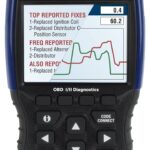Experiencing a sudden decrease in your vehicle’s engine power? A P0340 error code could be the culprit. This OBD-II trouble code signals issues within your vehicle’s camshaft position sensor circuit, leading to a range of symptoms beyond just a loss of power. These can include engine misfires, stalling, and various ignition system failures.
One of the more disruptive symptoms associated with a P0340 code is complete ignition failure. As the signal from the camshaft position sensor weakens or becomes erratic, your vehicle’s engine control unit (ECU) might be unable to properly time the ignition spark. This can result in a no-start condition, leaving you stranded. Beyond starting problems, keep an eye on your fuel efficiency. A malfunctioning sensor or compromised wiring can lead to the ECU injecting excessive fuel, drastically reducing your miles per gallon as the engine operates less efficiently.
Transmission problems can also surface due to a faulty camshaft position sensor circuit. In some vehicles, a P0340 code can cause the transmission to lock up, preventing gear shifts. If you find yourself unable to shift gears, but restarting the engine temporarily resolves the issue, it strongly suggests a problem within the camshaft position sensor system. This temporary fix occurs because restarting can sometimes reset the ECU, clearing the immediate error, though the underlying problem persists and the code will likely return.
Unpacking the Potential Causes of a P0340 Code
It’s a common misconception to immediately assume a P0340 code points directly to a faulty camshaft position sensor. While the code itself relates to this sensor, the root cause often lies in the electrical circuit connected to it. Therefore, simply replacing the sensor might not resolve the problem. Before reaching for a new sensor, consider these common causes that can trigger a P0340 error:
- Open Circuit in Wiring: A break or disconnection anywhere in the wiring leading to or from the camshaft position sensor can disrupt the circuit.
- Powertrain Control Module (PCM) Failure: In rare cases, a fault within the PCM itself can cause a P0340 code. The PCM is the computer that interprets sensor signals, and if it malfunctions, it can misread or fail to read signals correctly.
- Grounded, Broken, or Shorted Wiring or Connectors: Damaged wiring insulation can lead to short circuits, while corrosion or physical damage can cause broken wires or connector issues, all impacting the sensor circuit.
- Damaged or Failed Camshaft or Crankshaft Position Sensor: While not always the sensor itself, either the camshaft position sensor or, less directly, the crankshaft position sensor can be faulty and contribute to the P0340 error. These sensors work in tandem, and issues with one can sometimes affect the readings and operation of the other.
A thorough inspection of the sensor and its associated wiring is crucial to pinpoint the exact cause. Remember, a P0340 code specifically indicates a circuit malfunction, and this malfunction can stem from various electrical components within the system.
Troubleshooting and Solutions for a P0340 Error
Don’t be overwhelmed by the potential causes and concerning symptoms associated with a P0340 code. Numerous solutions exist, tailored to the specific circuit issue at hand. To effectively address the problem, understanding what the P0340 code signals is the first step. It indicates a problem in the camshaft position sensor circuit, not necessarily the sensor itself. Here’s a step-by-step approach to potential solutions:
First, locate your camshaft position sensor. Its location varies by vehicle, but it’s commonly found near the engine’s cylinder head, within the lifter valley, or adjacent to the engine block. This sensor plays a vital role in engine management by tracking the camshaft’s position relative to the crankshaft. This information is critical for precise ignition timing and fuel injection.
Begin with a visual inspection of the sensor, its wiring, and connectors. While sensor failure is possible, often the issue is as simple as a loose connector, a corroded terminal, or damaged wire insulation causing a short circuit and triggering the P0340 code. Try firmly reconnecting any loose connectors you find. Sometimes, simply ensuring a secure connection can resolve intermittent circuit issues.
If visual inspection reveals damaged wiring or corroded connectors, replacement is the next logical step. Over time, wiring can degrade, and connectors can corrode, leading to increased resistance and signal degradation within the circuit. A weak circuit to the camshaft position sensor can cause it to malfunction or provide inaccurate readings. Use a multimeter to test the voltage at the sensor connector to verify proper voltage and circuit continuity. This will help determine if wiring or connectors are the source of the problem.
Finally, don’t overlook the crankshaft position sensor and its circuit. The camshaft and crankshaft position sensors work interdependently. Symptoms arising from a crankshaft sensor issue can sometimes mimic those of a camshaft sensor problem, and a fault in one sensor or its circuit can indirectly impact the other. Therefore, inspect the crankshaft position sensor and its wiring as part of your diagnostic process. Once you’ve thoroughly inspected, repaired, or replaced any faulty wiring, connectors, or sensors, test drive your vehicle. Pay close attention to ignition, acceleration, and overall engine performance to confirm that the repairs have successfully resolved the P0340 error and restored your vehicle to optimal running condition.
